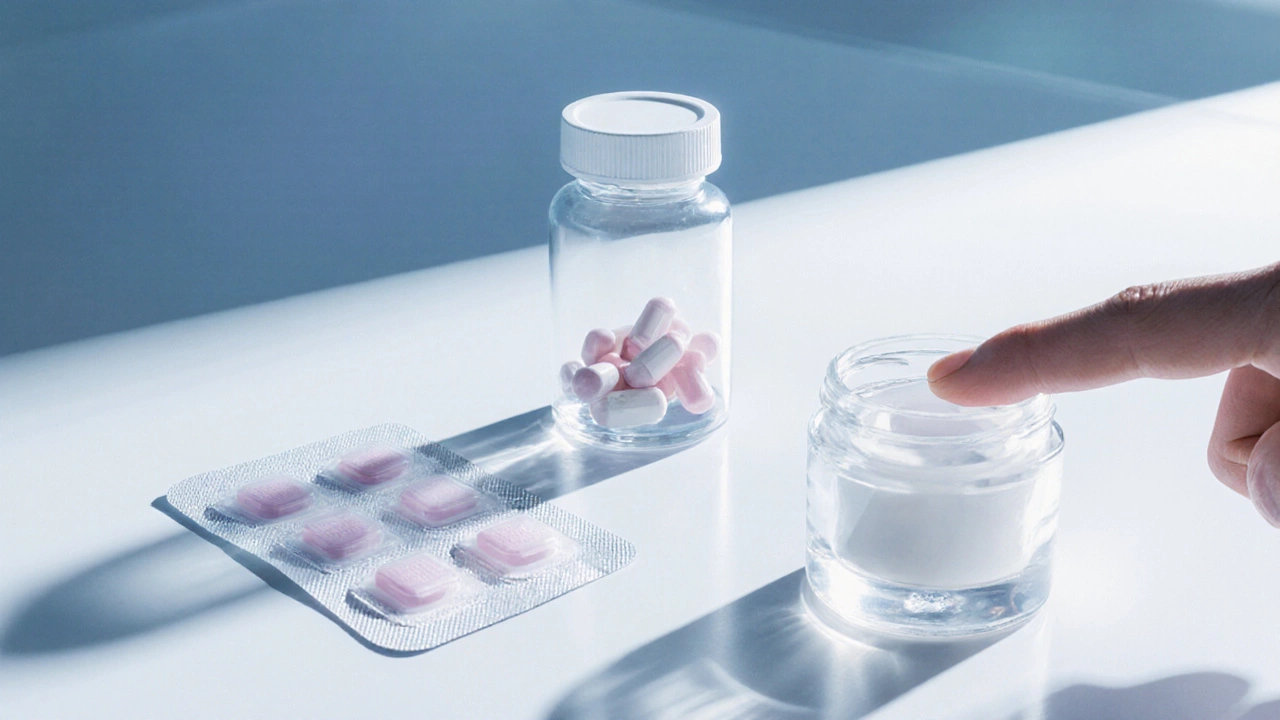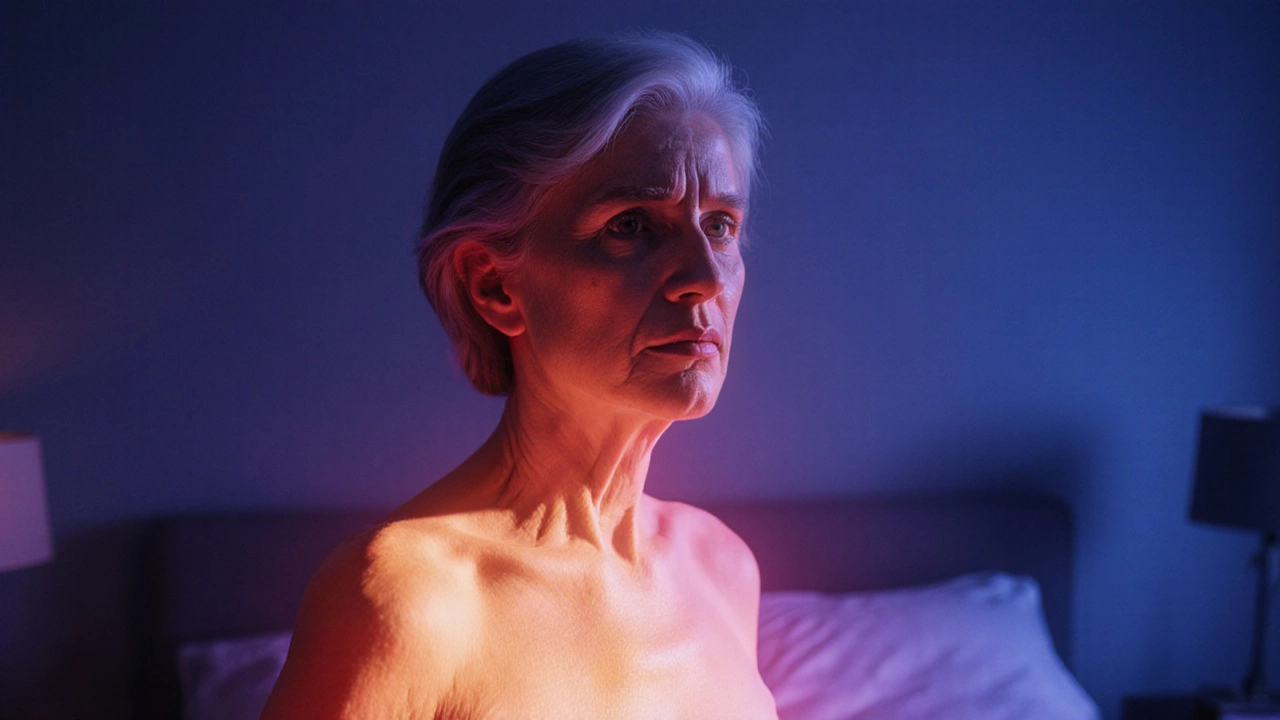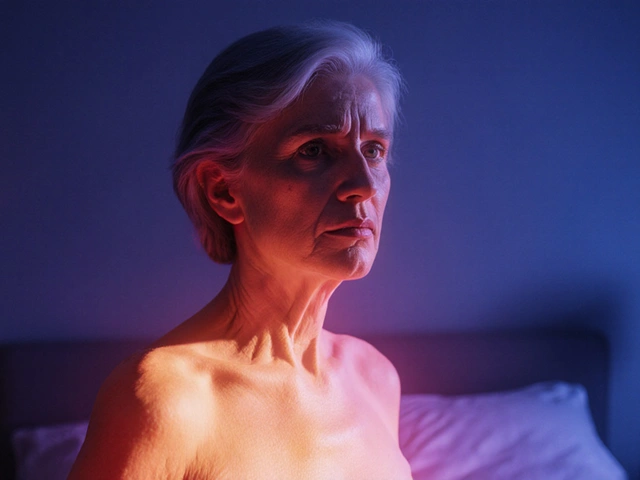Menopause Symptom Relief Calculator
Estimate Your Symptom Relief Potential
Answer a few questions about your symptoms and health profile to get an estimated benefit level from HRT.
Estimated Symptom Relief Potential
When a woman hits the late 40s or early 50s, the body starts to secrete far less of the hormones that kept everything running smoothly. The result? Hot flashes, night sweats, mood swings, and a gradual loss of bone strength. Many wonder if there’s a single hormone that can hit the pause button on these changes. The short answer is yes-Estrogen is the primary hormone used in hormone replacement therapy (HRT) to alleviate menopausal symptoms and delay the physical effects of estrogen decline. Below we’ll unpack how estrogen works, the different HRT options, and what you should weigh before starting a hormonal regimen.
Key Takeaways
- Estrogen, often combined with progesterone, is the hormone most commonly prescribed to stop menopause symptoms.
- Hormone Replacement Therapy (HRT) comes in estrogen‑only and combined estrogen‑progesterone forms, each suited to different health profiles.
- Benefits include reduced hot flashes, better sleep, and protection against bone loss; risks involve clotting, breast cancer, and cardiovascular concerns.
- Choosing the right regimen involves age, uterus status, personal and family medical history, and lifestyle preferences.
- Regular monitoring and open dialogue with a health professional are essential for safe, effective use.
Understanding Menopause
Menopause is the natural cessation of menstrual cycles that occurs when ovarian function declines, typically between ages 45 and 55. During this transition, estrogen and progesterone levels tumble, triggering the classic symptoms that many describe as “the change”. While menopause is a normal life stage, the speed and severity of symptoms can vary dramatically.
Symptoms fall into three buckets:
- Vasomotor: hot flashes, night sweats, rapid heartbeats.
- Mood & cognition: irritability, anxiety, memory fog.
- Physical: vaginal dryness, loss of bone density, changes in lipid profile.
Because estrogen influences virtually every organ system, the drop creates a ripple effect that can feel overwhelming.

How Hormone Therapy Works
Hormone Replacement Therapy (HRT) delivers synthetic or bioidentical forms of estrogen, sometimes paired with progesterone, to restore hormone levels to a pre‑menopausal range. By filling the gap, HRT targets the root cause of the symptoms rather than just masking them.
There are two main routes:
- Systemic delivery (pills, patches, gels, or injections) that circulates throughout the body.
- Localized delivery (vaginal creams, rings, or tablets) that mainly treats urogenital symptoms.
Systemic HRT is the one that tackles hot flashes and bone loss, which is why estrogen is the star of the show.
Estrogen: The Main Hormone Used
Estrogen isn’t a single molecule. The most potent form used in therapy is Estradiol (the bioidentical estrogen that closely mirrors the hormone produced by healthy ovaries. It can be delivered as:
- Oral tablets (e.g., estradiol valerate).
- Transdermal patches (steady release, lower liver impact).
- Topical gels (applied to skin, flexible dosing).
For women who have had a hysterectomy, estrogen alone is usually enough. If the uterus is intact, a progestogen must be added to prevent the lining from over‑growing, which could raise the risk of endometrial cancer.
Types of Hormone Replacement Therapy
The choice between estrogen‑only and combined therapy depends on three factors: uterus status, age, and personal risk profile. Below is a quick side‑by‑side look.
| Feature | Estrogen‑Only | Combined (Estrogen + Progesterone) |
|---|---|---|
| Typical Users | Women without a uterus (post‑hysterectomy) | Women with an intact uterus |
| Common Formulations | Estradiol pills, patches, gels | Estradiol + micronized progesterone; or conjugated estrogens + medroxyprogesterone acetate |
| Risk of Endometrial Hyperplasia | Low (no uterus) | Higher if progesterone omitted; mitigated when combined correctly |
| Impact on Breast Tissue | May slightly increase risk, but lower than combined | Slightly higher breast cancer risk in long‑term use |
| Effect on Bone Density | Strong protection | Strong protection (similar) |
| Typical Duration | 2-5 years, then reevaluation | 2-5 years, then reevaluation |
Some women opt for Bioidentical Hormone Therapy (BHT) custom-compounded hormones that match the molecular structure of natural hormones. While BHT can feel “more natural,” the FDA warns that compounded products aren’t always tested for purity or dosage accuracy.

Benefits and Risks
Menopause hormone therapy is effective for more than 80% of women who experience moderate to severe vasomotor symptoms. Here’s what you can expect:
- Hot flash reduction: 70‑90% report fewer or milder episodes within weeks.
- Sleep improvement: Fewer night sweats lead to deeper, uninterrupted rest.
- Bone health: Estrogen slows bone resorption, cutting fracture risk by up to 30% in the first five years.
- Mood stabilization: Some women notice a lift in mood and sharper memory.
But there’s a flip side. The biggest safety concerns, based on large cohort studies like the Women’s Health Initiative (WHI), include:
- Blood clots: Oral estrogen increases clot risk; transdermal routes lower it.
- Breast cancer: Combined therapy shows a modest increase after five years of use.
- Heart disease: Timing matters-starting HRT within ten years of menopause onset may be cardioprotective, while later initiation might raise risk.
- Stroke: Slightly higher incidence with certain oral formulations.
Because risk varies by age, personal health history, and lifestyle, the “one‑size‑fits‑all” myth is dead.
Choosing the Right Regimen
Here’s a practical checklist you can run through with your doctor:
- Uterus status: If you still have a uterus, insist on a combined regimen.
- Age & time since menopause: Women under 60 or within a decade of menopause generally have a better risk‑benefit profile.
- Personal history: Past clotting events, breast cancer, or liver disease may steer you toward non‑oral routes or lower doses.
- Preferred delivery method: Patches are great for steady dosing; pills are convenient; gels let you tweak dose day‑by‑day.
- Monitoring plan: Baseline blood work, annual mammograms, and bone density scans are standard.
After you start, give it 8-12 weeks to see symptom relief. If side effects pop up (headaches, breast tenderness, mood swings), adjust dose or switch delivery method before quitting outright.
Frequently Asked Questions
Can HRT reverse menopause?
No. HRT doesn’t bring back ovarian function, but it can mimic the hormonal environment, effectively “pausing” many symptoms.
Is estrogen‑only therapy safe for women with a uterus?
Only if a progesterone is added. Without it, the uterine lining can thicken, raising cancer risk.
How long should I stay on HRT?
Most guidelines suggest 2‑5 years, followed by a reassessment. Some women continue longer if benefits outweigh risks.
Do lifestyle changes reduce the need for HRT?
Regular exercise, a plant‑rich diet, and stress‑reduction techniques can lower hot flash frequency, but they rarely eliminate the hormonal gap entirely.
What’s the difference between bioidentical and conventional HRT?
Bioidentical hormones are chemically identical to natural hormones and are often compounded. Conventional HRT uses FDA‑approved, standardized doses. Both have similar efficacy; safety depends on formulation and monitoring.
Bottom line: estrogen-most often given as part of Hormone Replacement Therapy-is the hormone doctors use to halt the cascade of menopause symptoms. Whether you choose an estrogen‑only patch, a combined pill, or a bioidentical gel, the key is a personalized approach backed by regular check‑ups. Talk to a qualified health professional, weigh the benefits against the risks, and you’ll find a plan that lets you stay vibrant through the change.

